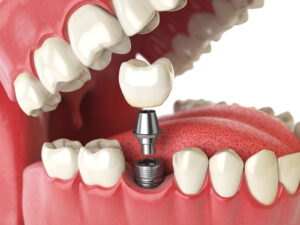
27 Haz What is Implant Treatment? How Is It Done?
Surgical placement of titanium roots in place of dental deficiencies is called implant therapy. These roots are integrated into the jawbone, forming a stable and durable structure. Porcelain teeth attached to them provide aesthetics and functionality similar to natural teeth. Treatment is a widely preferred method to solve the aesthetic and functional problems of tooth loss.
In Which Cases Is Implant Treatment Performed?

Traditional prostheses may cause discomfort for some people. Implants may offer a more comfortable option. In some cases, other dental treatment options may not be appropriate and do not provide adequate results. It can be used in such cases. These conditions generally cover situations where treatment may be preferred. It is best to discuss with a dentist about your suitability for implant treatment.
How is Implant Treatment Performed?
First of all, during the implant treatment process, the dentist examines the area where the missing tooth is located and creates a treatment plan. At this stage, the condition of the gums and jawbone is evaluated. If the jawbone is not of sufficient thickness and density, jawbone preparation is performed in a suitable way for the area where it will be placed. This is usually done with bone grafting or bone filling techniques. The implant is surgically placed in the jawbone. This procedure is usually performed under local anesthesia. An implant is a screw-like device made of a material compatible with the body, such as titanium. This device is firmly placed inside the jawbone, as it will serve as the tooth root. After the implant is placed, the tissues around the jawbone are expected to heal. This process can usually take several months. The implant fuses with the jawbone and this process ensures that the implant stays in place stably.
After the healing process is completed, a prosthetic tooth is placed on the implant. This prosthetic tooth is designed and placed by the dentist in accordance with the patient’s tooth color and jaw structure. Regular check-ups are important after the completion of the treatment. The dentist monitors the condition of the implant and prosthesis and offers maintenance recommendations if necessary. Implant treatment is a reliable option for permanently and naturally eliminating dental deficiencies. However, a detailed assessment of whether it is suitable for each patient is necessary. The course of treatment and the success rate may vary depending on the patient’s general health condition and the condition of the jawbone. Therefore, it is important that people considering treatment consult a dentist first.
Things to Be Considered After Implant Treatment

These checks are necessary to observe whether the implant is settling in a healthy way. You should avoid heavy physical activities during the period determined by your doctor after the operation. You must act in accordance with the rest period required for the implant to fuse with the bone. It is important to pay attention to dental hygiene after implant treatment. You should continue your routines, such as brushing and flossing, as recommended by your doctor. These suggestions are for general information purposes. Each patient may be different. Therefore, it is most accurate to determine your treatment plan and recommendations by discussing them one-on-one with your doctor.


